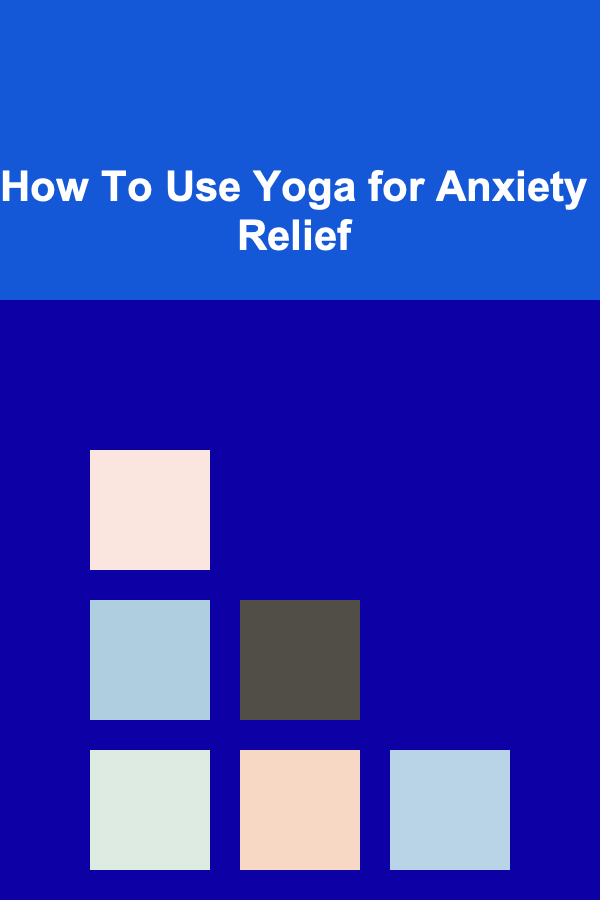
How To Use Yoga for Anxiety Relief
ebook include PDF & Audio bundle (Micro Guide)
$12.99$10.99
Limited Time Offer! Order within the next:

Anxiety has become one of the most common mental health issues worldwide. With the fast-paced, high-pressure environment of modern life, more and more people are seeking effective, natural ways to manage and reduce anxiety. While there are many methods available, one of the most powerful and holistic approaches is yoga.
Yoga, an ancient practice that originated in India, combines physical postures, breath control, meditation, and mindfulness. Over time, numerous studies have confirmed the efficacy of yoga in reducing stress, improving emotional well-being, and alleviating symptoms of anxiety. In this article, we will explore how yoga can be used as a tool for anxiety relief, delving into both the physiological and psychological mechanisms at play, and offering practical tips and yoga sequences for those seeking relief from anxiety.
Understanding Anxiety
Before delving into the specifics of how yoga can help with anxiety, it's important to understand what anxiety is and why it occurs. Anxiety is a natural response to stress, characterized by feelings of unease, worry, or fear. It's a common emotion that everyone experiences at some point, especially during challenging situations.
However, when anxiety becomes chronic or overwhelming, it can negatively affect one's physical and mental health. Anxiety disorders, which include generalized anxiety disorder (GAD), panic disorder, and social anxiety disorder, are often marked by persistent worry and physical symptoms such as rapid heartbeat, shallow breathing, and muscle tension.
Chronic anxiety has a profound impact on the body. It activates the sympathetic nervous system (the "fight or flight" response), which can lead to elevated cortisol levels, increased heart rate, and shallow breathing. Over time, these stress responses can contribute to long-term health problems, such as high blood pressure, digestive issues, and weakened immunity.
Yoga addresses anxiety in several ways by calming the nervous system, balancing the mind and body, and fostering a deep sense of awareness and presence.
The Benefits of Yoga for Anxiety
Yoga offers a multifaceted approach to managing anxiety. It is an integrative practice that works on both the mind and body simultaneously. Here are some of the key benefits yoga offers in relieving anxiety:
1. Activation of the Parasympathetic Nervous System
Yoga encourages the activation of the parasympathetic nervous system (PNS), often referred to as the "rest and digest" system. This contrasts with the sympathetic nervous system, which governs the body's fight or flight response.
By focusing on slow, deep breathing and relaxation, yoga helps reduce the hyperactivity of the sympathetic system and promotes a state of calm and relaxation. This helps counteract the physical symptoms of anxiety, such as rapid heart rate, shallow breathing, and muscle tension.
2. Mindfulness and Present Moment Awareness
A key aspect of yoga is mindfulness -- the practice of being fully present in the moment. In yoga, mindfulness is developed through conscious breathing (pranayama) and movement awareness in each posture (asana). This focus on the present moment helps distract from worry and negative thought patterns, which are often at the root of anxiety.
When practicing yoga, individuals are encouraged to let go of any judgment or self-criticism, promoting a sense of self-compassion and acceptance. This helps counteract the cycle of anxious thoughts that can often spiral out of control.
3. Reduction of Stress Hormones
Yoga can help reduce the levels of cortisol, a stress hormone that is often elevated during periods of anxiety. By practicing deep breathing techniques and holding postures that promote relaxation, yoga can encourage the body to release tension and lower cortisol levels, leading to a calmer state.
4. Physical Relaxation and Tension Release
Anxiety often manifests physically through muscle tension, particularly in the neck, shoulders, and jaw. Regular yoga practice helps to release this tension, improving flexibility and posture. Through the practice of various poses, yoga stretches and strengthens muscles, releasing built-up tension and promoting a deep sense of relaxation.
5. Improved Sleep Quality
Many people with anxiety struggle with sleep disturbances, including difficulty falling asleep and staying asleep. Yoga has been shown to improve sleep quality by calming the nervous system and reducing racing thoughts before bedtime. The practice of gentle yoga poses and relaxation techniques can promote a restful night's sleep, which is essential for overall mental well-being.
Yoga Practices for Anxiety Relief
Now that we understand the physiological and psychological benefits of yoga, let's explore specific yoga practices that can help reduce anxiety.
1. Pranayama (Breath Control)
Breath control is one of the most important elements of yoga, especially when it comes to calming anxiety. Breath is directly linked to the nervous system -- by regulating the breath, you can influence your body's stress response.
Ujjayi Breath (Victorious Breath)
Ujjayi breath involves breathing deeply through the nose while gently constricting the back of the throat to create a soft hissing sound. This breath is calming and helps regulate the flow of air, promoting relaxation.
To practice Ujjayi breath:
- Inhale deeply through the nose, expanding the belly.
- Exhale slowly, making a soft "ha" sound at the back of the throat.
- Focus on the sound and rhythm of the breath to anchor yourself in the present moment.
Nadi Shodhana (Alternate Nostril Breathing)
Nadi Shodhana is a powerful breathing technique that balances the nervous system and calms the mind. It involves alternating breaths between the nostrils, promoting equilibrium between the left and right hemispheres of the brain.
To practice Nadi Shodhana:
- Sit comfortably with your spine straight.
- Using your right hand, close your right nostril with your thumb and inhale deeply through your left nostril.
- Close your left nostril with your ring finger, then release your right nostril and exhale slowly.
- Repeat the process, alternating nostrils for 5-10 rounds.
This technique is excellent for calming the mind and reducing feelings of anxiety.
2. Asanas (Yoga Poses)
Yoga poses are designed to open the body, release tension, and promote relaxation. Here are some of the most effective asanas for anxiety relief:
Child's Pose (Balasana)
Child's pose is a restorative posture that promotes deep relaxation and releases tension in the back and neck.
- Start on your hands and knees.
- Sit back onto your heels and extend your arms in front of you, lowering your forehead to the mat.
- Breathe deeply into your belly, letting go of any tension in your body.
This pose helps calm the mind and encourage relaxation.
Cat-Cow Pose (Marjaryasana-Bitilasana)
This dynamic sequence of poses helps relieve tension in the spine, shoulders, and neck while synchronizing breath with movement.
- Start on all fours with your hands directly under your shoulders and your knees under your hips.
- Inhale, arch your back, drop your belly towards the floor, and look upward (Cow Pose).
- Exhale, round your spine, tuck your chin to your chest, and draw your belly button toward your spine (Cat Pose).
- Repeat for several breaths, moving fluidly between the two poses.
This sequence helps to release physical tension and bring focus to the breath.
Forward Fold (Uttanasana)
This pose stretches the hamstrings, relieves tension in the neck, and encourages a calming effect on the nervous system.
- Stand with your feet hip-width apart.
- Slowly fold forward from the hips, letting your head and neck relax toward the floor.
- Allow your hands to touch the ground, or place them on blocks or your legs if needed.
- Breathe deeply and relax in this position for several breaths.
Forward fold promotes relaxation and reduces stress in the body.
Legs Up the Wall Pose (Viparita Karani)
This restorative pose helps to calm the nervous system, reduce stress, and improve circulation.
- Sit next to a wall and gently lie down, swinging your legs up the wall.
- Keep your arms by your sides, palms facing up.
- Close your eyes and focus on your breath.
- Stay in this pose for 5-10 minutes, allowing your body to fully relax.
This pose is particularly effective for calming the mind and reducing feelings of anxiety.
3. Meditation and Mindfulness
While yoga poses are excellent for anxiety relief, incorporating meditation and mindfulness into your practice can further enhance its effectiveness. Meditation helps to quiet the mind and reduce the constant stream of anxious thoughts.
4. Restorative Yoga
Restorative yoga is a gentle form of yoga that uses props such as blankets, cushions, and blocks to support the body in comfortable, passive poses. This type of yoga is particularly beneficial for individuals dealing with chronic anxiety, as it encourages deep relaxation and stress relief.
In a restorative class, you might hold poses for several minutes, allowing the body to fully release tension. This practice promotes a deep sense of calm and helps reset the nervous system.
Tips for Incorporating Yoga into Your Anxiety Management Routine
To get the most out of yoga for anxiety relief, consider the following tips:
- Consistency is Key: Practice yoga regularly, even if it's just for 10-20 minutes each day. Consistency will help train your body and mind to respond to stress in a healthier way.
- Focus on the Breath: Use breath control as your anchor. When anxiety arises, focus on your breath to calm the nervous system and center your mind.
- Listen to Your Body: Avoid pushing yourself too hard in poses. Yoga is about cultivating awareness and self-compassion, so honor your body's limits.
- Find a Calm Environment: Practice yoga in a quiet, peaceful environment where you can relax and fully immerse yourself in the practice.
- Incorporate Meditation: Alongside yoga postures, incorporate mindfulness and meditation to further calm your mind and reduce anxious thoughts.
Conclusion
Yoga is a powerful tool for anxiety relief, offering a holistic approach that addresses both the physical and mental aspects of stress. By focusing on mindful breathing, relaxation, and movement, yoga can help reduce anxiety, release tension, and restore balance to the nervous system. Whether practiced in a class or at home, yoga provides an accessible and effective way to manage anxiety and improve overall well-being.
Incorporating yoga into your daily routine can help you build resilience to stress and develop a deeper connection to yourself. With regular practice, you can cultivate a sense of calm and peace, both on and off the mat.

How to Add More Natural Light During Your Home Renovation
Read More
How to Use Natural Cleaning Products for a Healthy Home
Read More
How to Use One-Page Websites for Event Invitations and Registrations
Read More
Managing Screen Time for Teenagers: A Comprehensive Guide
Read More
Embracing Slow Living in a Fast-Paced World
Read More
10 Tips for Snooker Beginners: A Comprehensive Guide
Read MoreOther Products

How to Add More Natural Light During Your Home Renovation
Read More
How to Use Natural Cleaning Products for a Healthy Home
Read More
How to Use One-Page Websites for Event Invitations and Registrations
Read More
Managing Screen Time for Teenagers: A Comprehensive Guide
Read More
Embracing Slow Living in a Fast-Paced World
Read More